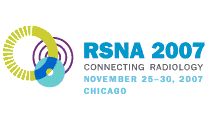
Abstract Archives of the RSNA, 2007
SSA15-06
Automatic Lung Segmentation from Chest CT Scans Using a Hybrid Algorithm Robust against Pathology
Scientific Papers
Presented on November 25, 2007
Presented as part of SSA15: Physics (Thoracic CAD )
Eva Marjolein van Rikxoort, Presenter: Nothing to Disclose
Mathias Prokop MD, Abstract Co-Author: Medical Board, Koninklijke Philips Electronics NV
Bram Van Ginneken PhD, Abstract Co-Author: Nothing to Disclose
Standard algorithms for segmenting the lungs on CT chest scans fail when large or subpleural abnormalities are present. A new hybrid lung segmentation method is presented that automatically detects failures of a standard algorithm and resorts to an advanced atlas-based algorithm when needed.
Volumetric CT scans (Philips Mx8000IDT, 16 x 0.75 mm collimation) were used: 1360 scans taken from the NELSON lung cancer screening program (30 mAs) and 250 clinical scans (50-120 mAs) from a database of patients with interstitial lung disease. The lungs in all scans were automatically segmented with a fast algorithm based on region growing and morphological
processing. Next, segmentation failure was automatically detected based on statistical deviation from a range of volume and shape measurements. To scans with failures an advanced multi-atlas based algorithm using non-rigid registration was applied. Results were visually inspected.
The standard method required on average 55 seconds per scan. Error detection took 4 seconds per scan and the atlas-based method took on average 80 minutes, all on a single high-end PC. Among the lung cancer screening scans all 7 errors were automatically detected (0.5%). Error detection was correct in all cases. Errors were caused by pathologic abnormalities, the atlas-based method correctly segmented these scans. Total average segmentation time was 79 seconds. In the scans with interstitial lung disease 84 failures (34%) were automatically detected, segmentation was correct in other cases. 3 scans were erroneously labelled as failure, in all other cases failures were caused by pathologic changes. The atlas-based method correctly segmented 70 (83%) of those 84 cases. Total average segmentation time was 27 minutes.
Hybrid lung segmentation that relies on standard image processing techniques and resorts to atlas-based segmentation when failures are detected is generally fast and produces accurate results even in scans with severe pathologic abnormalities.
Automatic lung segmentation is a prerequisite for computerized analysis of chest CT. A new method that combines a faster and a sophisticated method
to be robust against pathologies is presented.
van Rikxoort, E,
Prokop, M,
Van Ginneken, B,
Automatic Lung Segmentation from Chest CT Scans Using a Hybrid Algorithm Robust against Pathology. Radiological Society of North America 2007 Scientific Assembly and Annual Meeting, November 25 - November 30, 2007 ,Chicago IL.
http://archive.rsna.org/2007/5015605.html

